Looking for the best kids' bike for your child in 2023 and finding it hard to pick the best children's bike for your little one? Relax, we’ve put together a simple guide to help you choose wisely.
Positive early experiences can have a huge effect on our lives. With cycling being an incredibly fun way to get about in an environmentally friendly way, keep fit and socialise, encouraging kids to cycle is a fantastic idea.
Having the right bike can make a big difference to a child’s early cycling experiences and ultimately help them to enjoy the sport we love.
From finding the right size bike to product recommendations for a range of age groups, our buyers guide to the best kids’ bike at the bottom of the page has it covered.
Once you’ve found the perfect bike, why not check out our guide to cycling with kids to get things started. Before you know it, the whole family will be out enjoying life on two wheels. We've got loads of other info on kids' bikes, from advice on kids' cycling and commuting to school to reviews of kids' bikes tried, tested and abused by our junior riders.
Below are our picks of the best kids' bikes by age group, or scroll further for buying advice on how to choose the best kids' bikes, along with loads of other info including choosing helmets, balance bikes versus stabiliser wheels and more. The first step is to decide what size bike your child needs though.
- Best bikes and balance bikes for ages 1 to 4
- Best bikes for ages 4 to 6
- Best bikes for ages 6 to 10
- Best bikes for ages 10 to 13
- Best bikes for teenagers
What size bike does my child need?
Ages 4 to 6
For children aged four to six, measuring around 105cm to 115cm / 3ft 5in to 3ft 9in, go for a bike with 14in to 16in wheels. Most of these are simple bikes with pedals and brakes, and many come with a small range of gears.
Ages 7 to 10
For ages seven to 10 (height 115cm to 135cm / 3ft 9in to 4ft 5in), choose a bike with 18in to 20in wheels. You’ll also start to see a wider range of gears appearing at this price point, and you may find bikes with front suspension, which are more suitable for rough terrain.
Ages 10 to 13
Children aged between 10 and 13 (height 135cm to 150cm / 4ft 5in to 5ft) will usually move on to a 24in-wheel bike and, at this point, you’ll find bikes that are essentially a smaller version of an adult bike.
You’ll also start to see different types of bike, from junior-sized road bikes and mountain bikes to hybrid/leisure bikes. Choose a bike type that’s going to suit the majority of the riding your child will be doing – if it’s mostly going to be off-road, wide tyres with a grippy tread are a good choice, for example.
Teenagers
For teenagers, you’re going to be looking at adult bikes in smaller sizes. There are smaller wheel-size options for junior road bikes, such as 650b, but most bikes will have 26in, 27.5in or 700c wheels.
Bear in mind that these sizes are a guideline only. If your teen is taller or smaller than average, or more or less confident, they may be better off on a different size. If in doubt, talk to your local bike shop.
Best bikes and balance bikes for ages 1 to 4
Your child has just started walking and you're keen to make the transition from a child's bike seat to the bike for your budding rider as natural as possible. Enter, stage left, the balance bike.
Weight is a surprisingly important factor here.
No, your kid’s not looking to get airtime or take on a hill climb race just yet – but compared to a toddler, the weight of a bike is really significant. The lighter you can afford within your budget, the better, because this is likely to make it much easier for your child, and hence more enjoyable.
Although some more basic balance bikes won’t be fitted with a brake, it’s a good idea to look for one that does. Your child can learn this important skill in the early stages, before moving on to a pedal bike. This is especially important if your local playground or park is a bit hilly.

Balance bikes that have an easily adjustable seatpost can also be a good idea, because this can be adapted as they grow.
Finally, look for a balance bike that’s made to last. Dragged through the mud, splashed through puddles and maybe even left out in the rain: you want a bike that’ll stand up to the rigours of heavy use and still be in good condition to pass on or sell after. Alloy bikes tend to last better than wooden-style balance bikes.
There are also some pedal-powered options for two- to four-year-olds, and many will come with brakes – either lever-operated ones or coaster brakes that work by back-pedalling, and sometimes both.
We have a guide dedicated to the best balance bikes if you need more options.
Woom 1
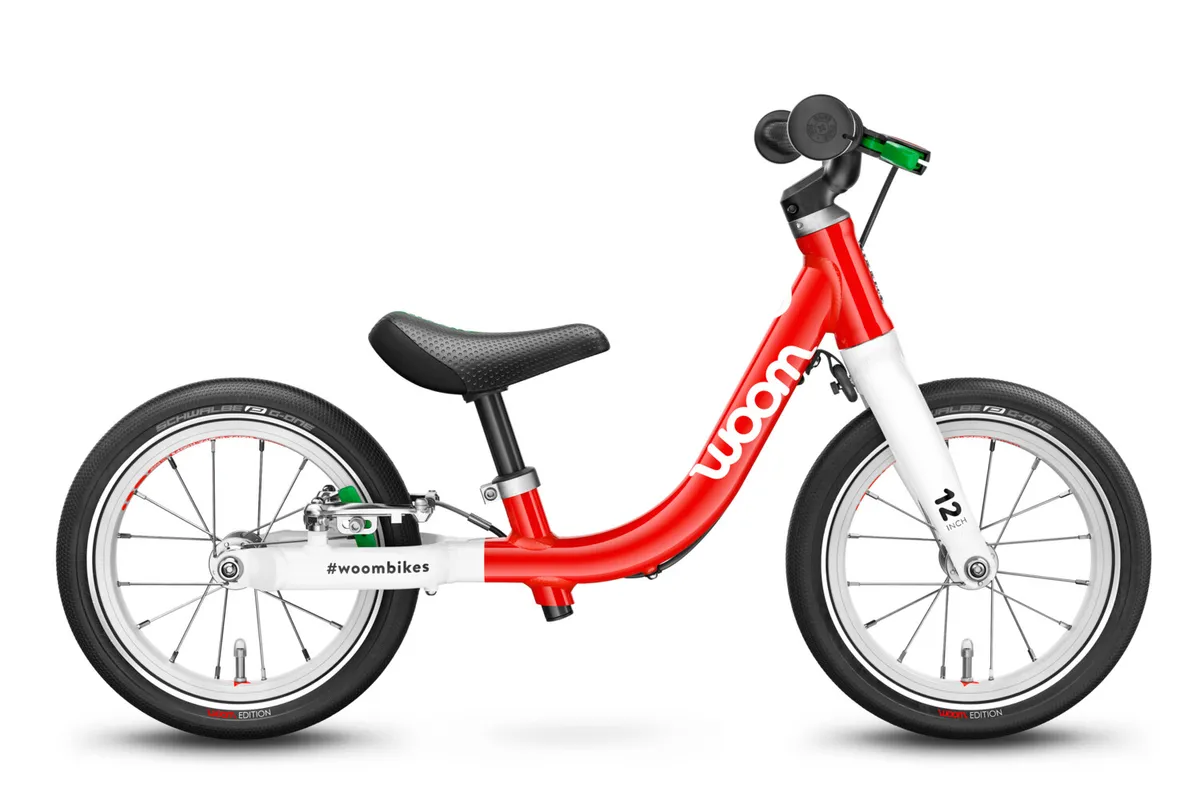
- €199 / $199
- Lightweight
- Includes a rear brake
Kids' bike specialists Woom’s first offering is this 2.95kg balance bike, the Woom 1. The lightweight aluminium frame rolls on 12in wheels and features a rear brake, so your child can get used to braking and steering from the get-go.
Every component is carefully considered with the beginner rider in mind, from the narrow grips to the ergonomic saddle.
Choose from five fun, bright colourways.
Strider 12 Sport Balance Bike
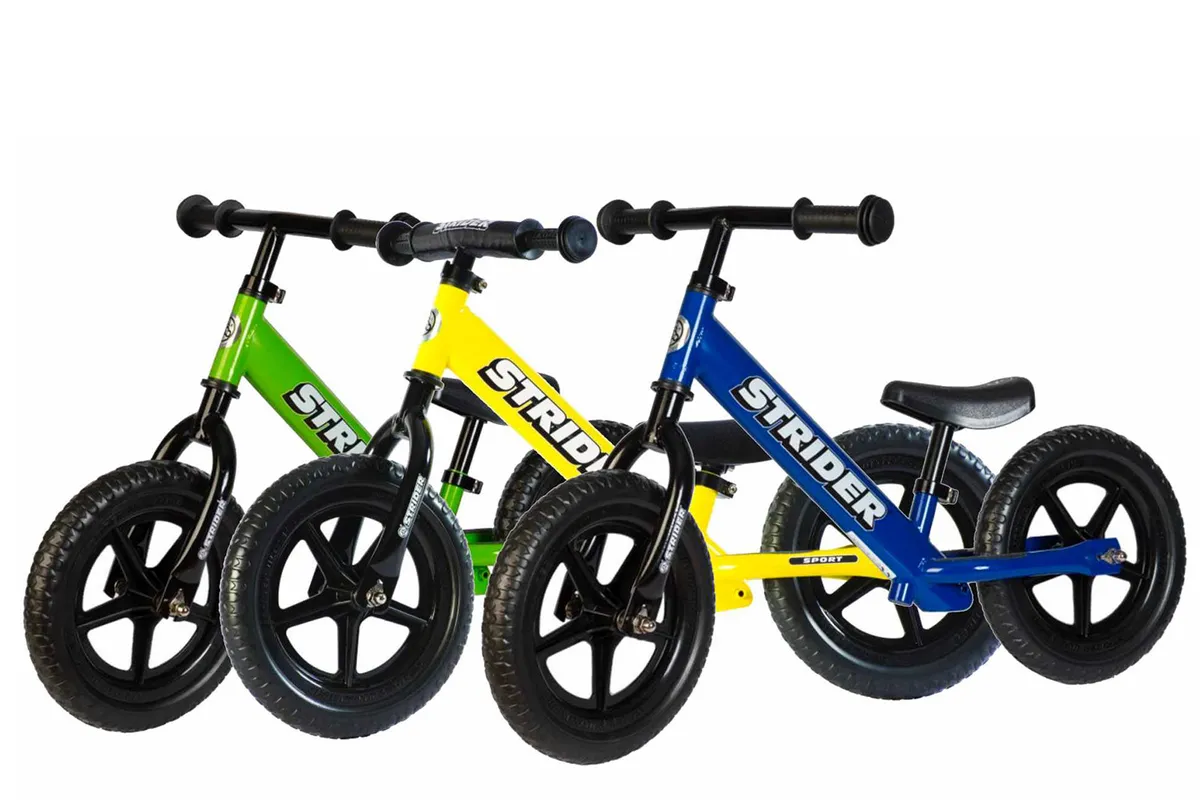
- £129.99 / €131.08 / $156 / AU$233
- Adjustable for a wide age range
- Includes footrests
The Strider Sport Balance bike is suitable for children aged from 18 months, up to four to five years. It features a long seatpost that can be lowered fully or raised high to fit your child.
A durable steel frame should withstand some rough treatment and the tyres are designed to be puncture-proof.
We like the built-in footrests, so when your child gets the hang of gliding along on the bike, they’ve got somewhere to rest their feet. It's the perfect preparation for moving on to pedals.
The bike is also designed so the saddle and handlebar height can be adjusted without tools.
Islabikes Rothan

- £199.99
- Specially shaped saddle for scooting
- Rear brake
Islabikes is a British company founded by Isla Rowntree, who is dedicated to creating high-quality bikes designed so that children develop a passion for cycling. Great care is taken to ensure the bikes fit well, ride well and aren’t too heavy for little riders to manage.
Available in a range of bright, cheerful colours, the Rothan has a lightweight aluminium frame, chunky tyres with plenty of grip and it even features a brake designed for smaller hands.
Frog 40
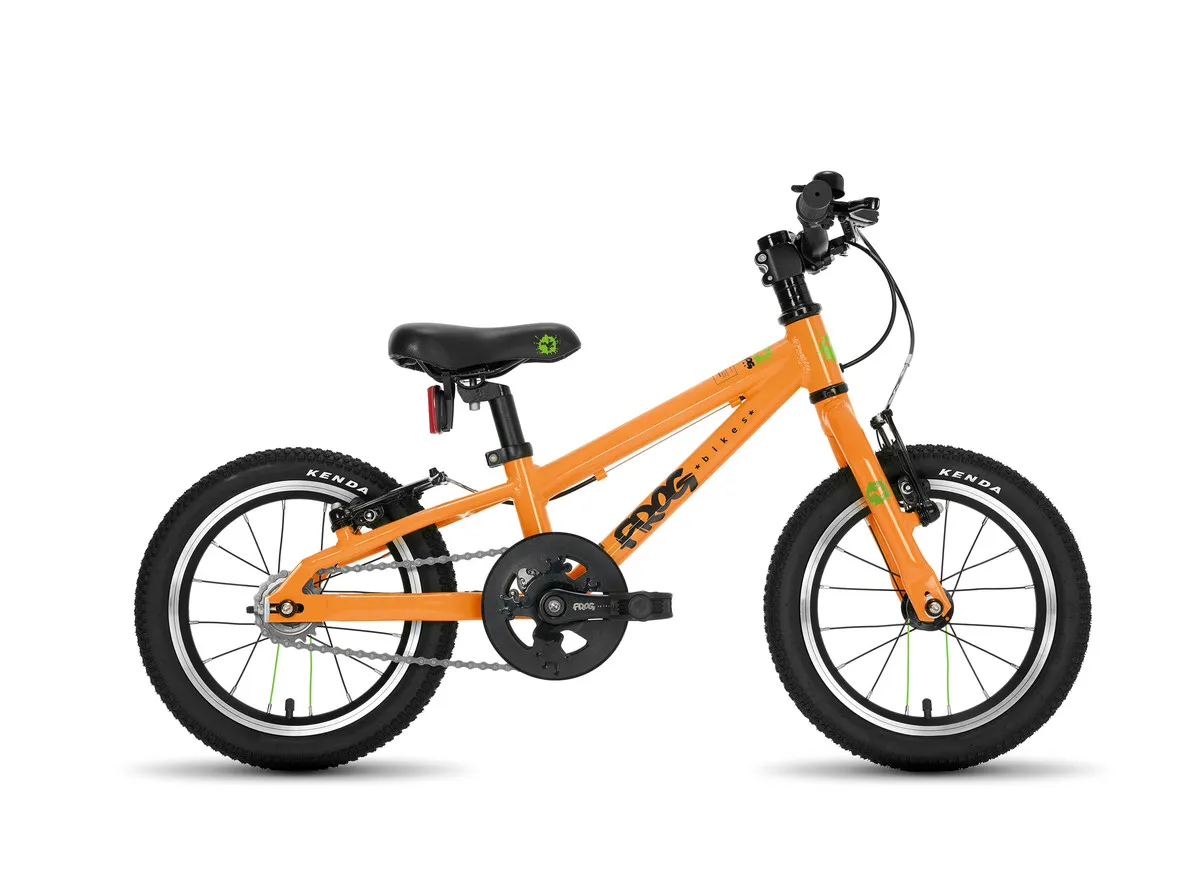
- £355 / €445 / $490
- Front and rear brakes
- Child-size crankset
If your child has already mastered gliding and is ready to move on to a bike with pedals, the Frog 40 is one to consider.
The Frog 40 has an aluminium frame and fork, as well as quality Tektro brakes for plenty of stopping power. There are also 89mm bespoke cranks designed to make pedalling easier for little kids.
The 14x1.5in Kenda tyres are designed to work well on a wide range of surfaces. A five-year warranty on frame and forks should bring peace of mind.
Frog also makes a popular line of balance bikes and models for older children.
Black Mountain Bikes Pinto

- £399 / €478.95
- Designed to adapt as they grow
- Belt drive for low maintenance
Black Mountain Bikes are designed to grow as kids grow. This means one bike will last your child for longer and is designed to fit children even better as they get taller. The brand says its bikes are "three bikes in one".
The Pinto can start off life as a balance bike, then work as a pedal cycle on the 14in wheel option. The frame is designed to be light (a claimed 6kg), which is easier for smaller children to handle, has a low-maintenance belt drive and short-reach brake levers for smaller hands, plus a raft of other features.
The gearing can also be made harder as your child grows thanks to a removable sprocket 'jacket'.
There are four colours available – orange, neon green, purple and sky blue.
Cube Cubie 120 Walk
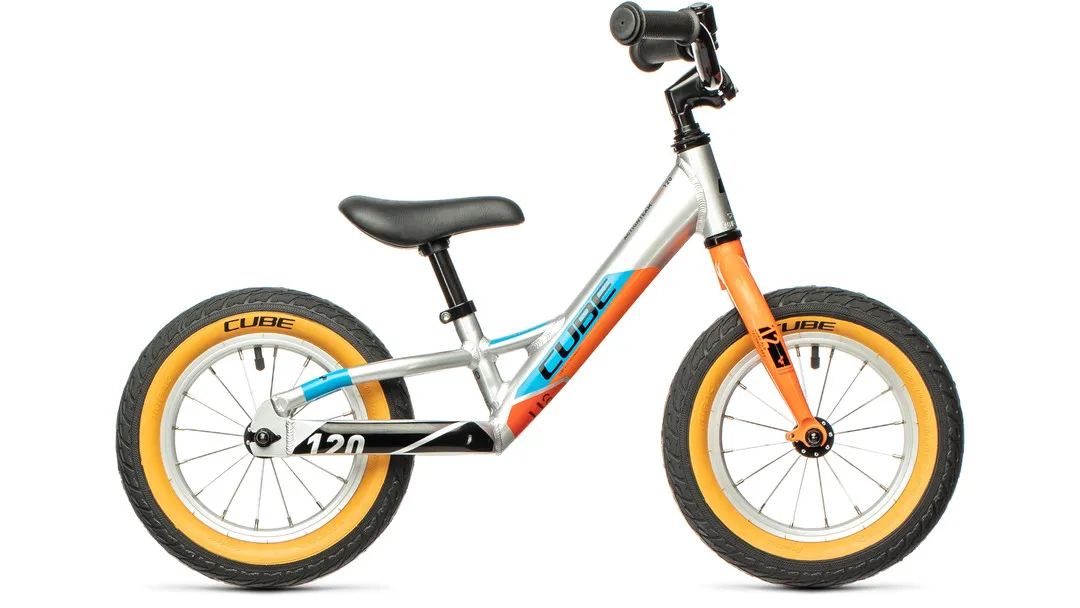
- £199 / €211 / $220 / AU$323
- Stop to prevent overturning the handlebar
- Comes with two seatpost lengths
This cutely named alloy bike weighs 3.8kg, making it a good lightweight option for your child to get started on.
Cube has incorporated a special handlebar setup that limits how far the rider can turn the bar, saving them from some of the inevitable accidents when they're learning.
Rolling on 12in wheels with Kenda Team Cube tyres, it has a low standover height and even comes with two different-length seatposts to allow growing room.
Specialized Hotwalk
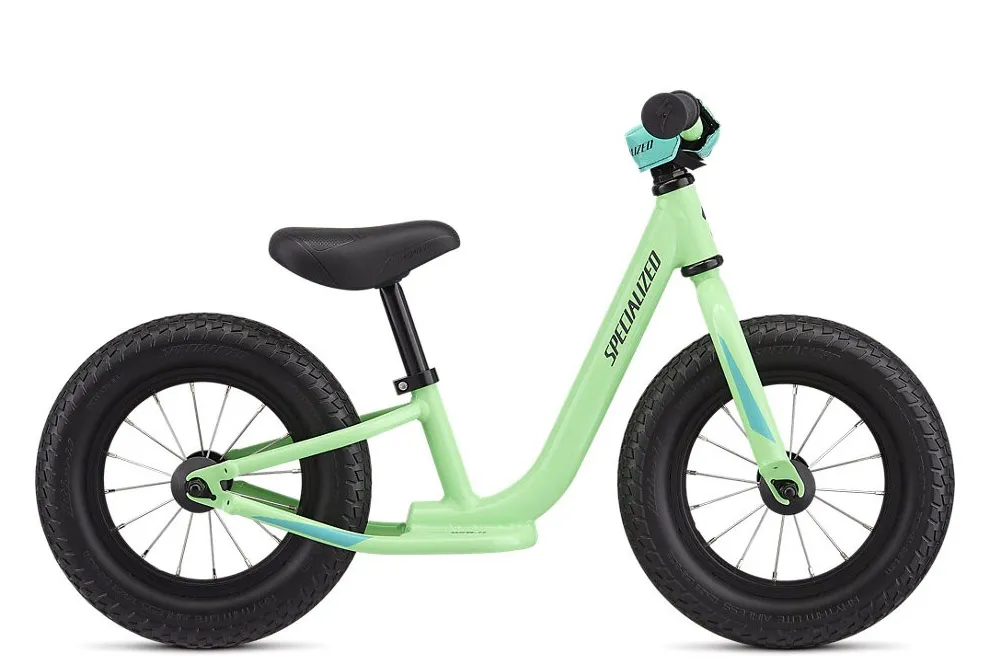
- £149 / €200 / $225 / AU$280
- Step-through frame option
- Includes a foot platform
Specialized’s Hotwalk comes with foot platforms, which are great for when little ones have got the hang of balancing, before transitioning to pedals.
It’s available with a step-through frame or a top-tube frame, and there’s also an adjustable bar-height option for growing children.
Specced with Specialized’s airless Rhythm Lite Sport tyres, it’s equally at home on dirt or tarmac and won’t suffer punctures.
For a 2.1kg lightweight (yet eye-wateringly priced) alternative, check out the Specialized Hotwalk Carbon.
Best bikes for ages 4 to 6

By now, the skills of the balance bike have been well and truly mastered. Your kid is zipping about in front of you, flinging legs to gain speed, cornering with confidence and braking effectively. It’s just the time to think about adding the next element into the mix: pedalling.
Moving from a balance bike to a pedal bike is a really crucial step, and fit is key here.
You need to make sure that your child can comfortably reach the floor with their feet when seated in the saddle, as well as reaching the handlebars and crucially the brake levers.
To keep it simple, your child’s first pedal bike might only have a single gear, or a couple of gears, to choose from. Once they’ve mastered the art of pedalling, they can move on to having many more gears as they grow and size up to bigger bikes.
Just like with a balance bike, having a lightweight option here is also really helpful, as your child is likely to still be very small.
The riding position is best if it is relatively upright. As they get to grips with pedalling, this will help them focus on what’s going on around them.
These bikes typically measure up with 14in or 16in wheels. If the bike was already supplied with stabilisers, and your child is confident riding without them, then remove them ASAP.
Most kids’ bikes in this price bracket should allow you to adjust the reach to the brakes. Many also have coaster brakes rather than lever-operated brakes, which are operated by back-pedalling.
Early Rider Belter 16in

- £439 / $439
- Low-maintenance Gates belt drive
- Big tyres for go-anywhere riding
The 5.9kg Belter from Early Rider is a fantastic first pedal bike.
Early Rider has chosen to spec a Gates rubber belt where you'd normally find a chain. This is a great idea on a kids' bike because the belt requires no oiling and won't get dirty like a regular chain.
The shiny aluminium frame looks good and is lightweight, and overall this is a bike that’s been built with care and attention to detail.
The 16in Vee mountain bike tyres look the part at 2in wide and are perfect for carving on those thrilling muddy slopes, rolling over roots or zooming across gravel. There are also powerful Tektro v-brakes front and rear, with special short-reach levers for small hands.
Orange Pop 16

- £450 / $600
- Miniature mountain bike with wide tyres
- Singlespeed for ease of use
A great transition from striding to pedals is the 16in Orange Pop. It's a proper shrunken mountain bike for the promising young ripper.
The frame follows the same long, low and slack mantra of Orange's big bikes. It's a singlespeed, so there are no gears to struggle with or break, and the proper 2.15in Kenda tyres are another highlight. The frame comes in either the orange shown or a blue colour.
Ridgeback MX16
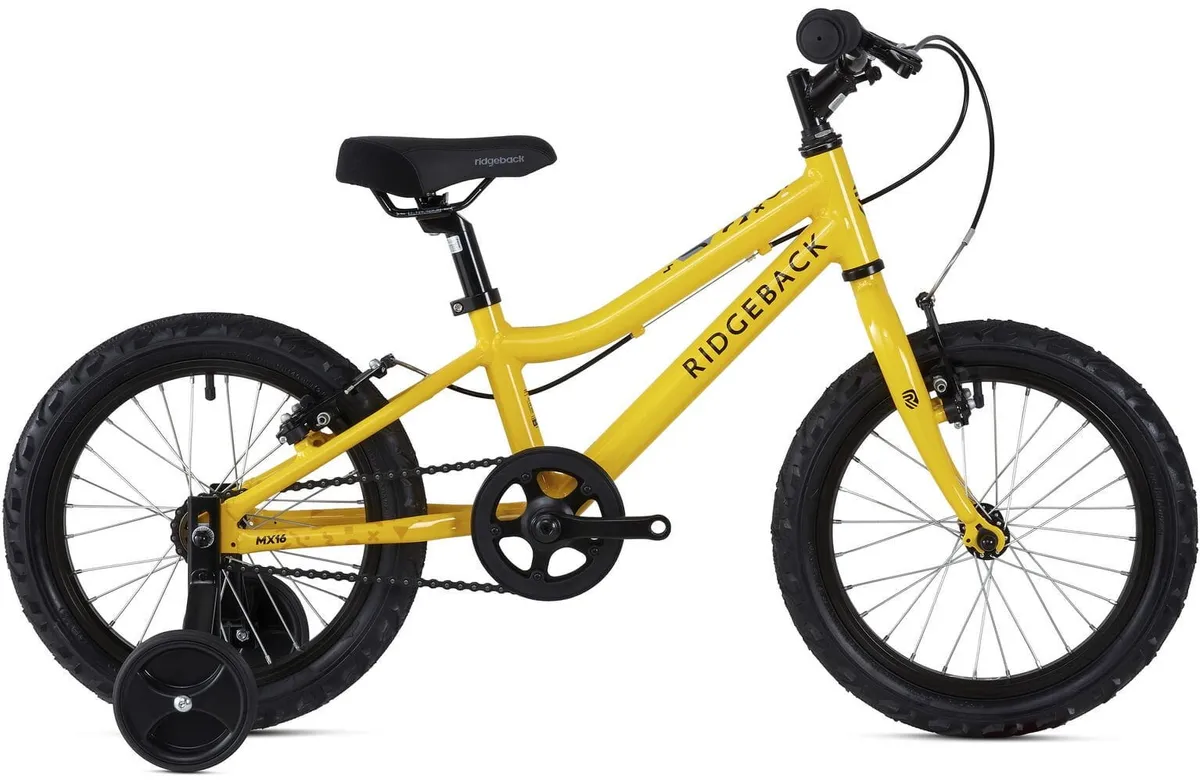
- £219.99
- Singlespeed simplicity
- Front and back V-brakes
The Ridgeback MX16 is a miniature mountain bike with 16in wheels wrapped in grippy Vee VRB tyres.
The MX16 has an alloy crossbar frame and steel fork. It’s intended for riders between 110cm and 120cm tall and has a claimed weight of 9.4kg.
The singlespeed gearing comprises a 16t cog and 32T crank. This should be easy for little legs to spin and removes the need to change gear.
Tektro brake levers pull on the Ridgeback’s Promax V-brakes.
Black Mountain Bikes Skøg

- £399 / €461.95
- Another Black Mountain bike that can grow with your kid
- Lightweight frame
Like its little sibling the Pinto, the Skøg works essentially like three bikes in one.
Without the pedals and belt drive fitted, it's a balance bike. Pop the pedals on and it will work as a regular pedal bike, except – and here's the cool bit – the frame and gearing can be adapted to suit the rider. So smaller kids can have as good a fit as possible and the bike can change with them.
The bikes are designed to be light and therefore easier for smaller people to ride, and have good-quality brakes with levers designed for small hands.
It's available in four bright colours – purple, neon green, sky blue and orange.
Best bikes for ages 6 to 10
Your child’s second pedal bike may not only increase in size, but in features too. The bigger wheels (18-20in) will be shod with wider tyres, and the larger frame will be complemented with slightly wider handlebars and longer cranks.
You’re likely to find more gears on a bike of this size, as your child learns how to use these effectively on longer rides involving more challenging inclines and descents.
You’ll also start to see suspension making an appearance (usually suspension forks only).
Bear in mind that cheaper suspension bikes can be heavier than their non-suspension alternatives (see the buyer's guide below), and if the bike is to be ridden off-road, some good-quality, wide, puncture-resistant tyres should be a higher priority.
Specialized Riprock 20
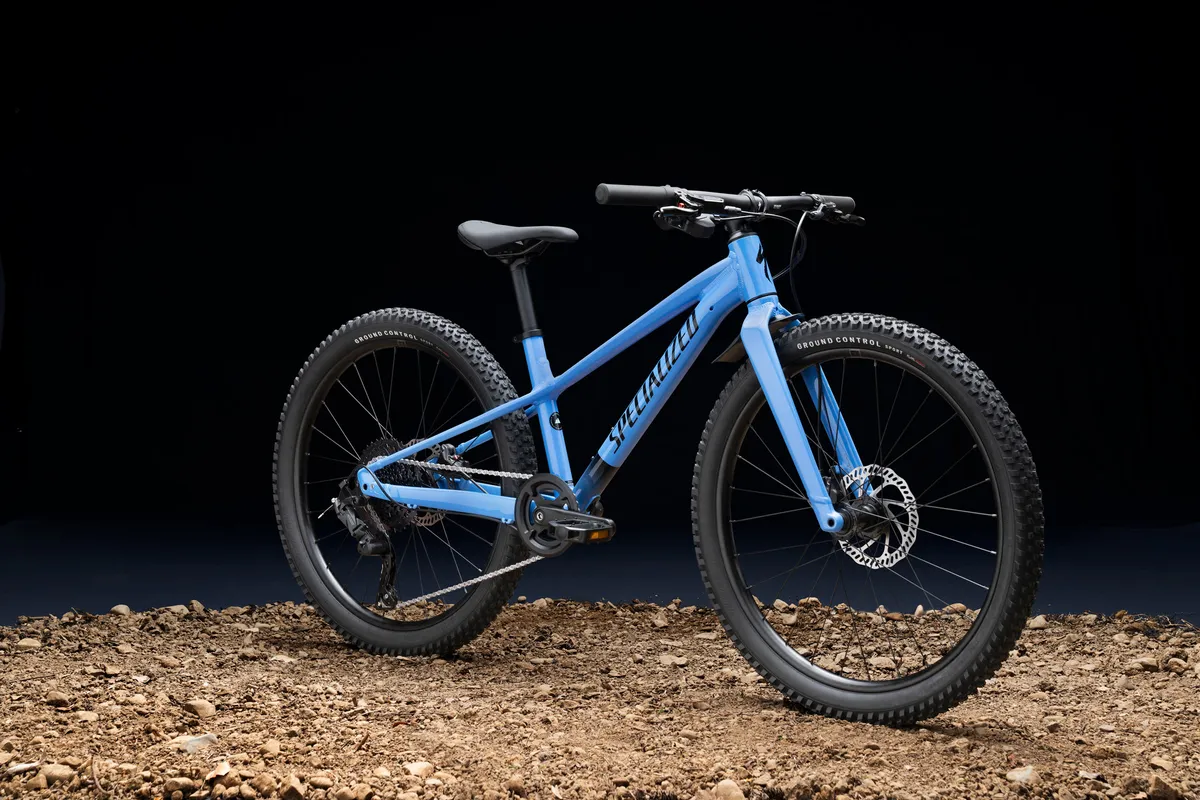
- £629 / €600 / $650 / AU$925
- Mountain bike styling
- Hydraulic disc braking
Replacing the popular Hotrock, Specialized’s new Riprock 20 is like an adult’s mountain bike in miniature, bar the suspension. It’s now generally accepted that getting the basics dialled without the added complication (and weight) of suspension is a smart way to go.
There are two sizes available, the 20in-wheel model, or the larger 24in model for taller kids. When it comes to more technical features, the 24in Expert model does use a 10mm-travel Manitou suspension fork.
Whether it’s fire roads, trails, urban commutes or sessioning the pump track, the Specialized Riprock is well equipped to tackle it all.
The Riprock also comes in a great range of colours.
Scott Scale/Contessa 20

- £389 / €429 / $600 / AU$650
- 7-speed gears
- 40mm-travel suspension fork
The Scott Scale 20 and girls' Contessa 20 are very much shrunken-down versions of Scott’s hardtail mountain bikes.
There’s an SR Suntour suspension fork that offers 40mm of travel to maximise grip and take some strain off the wrists, while chunky 2.2in Kenda Booster tyres should make light work of muddy conditions.
Shimano 7-speed gearing is grip-shift operated, and child-specific v-brakes provide the stopping power. Handlebars, saddle and pedals are all designed with a junior rider in mind.
Trek Roscoe 20
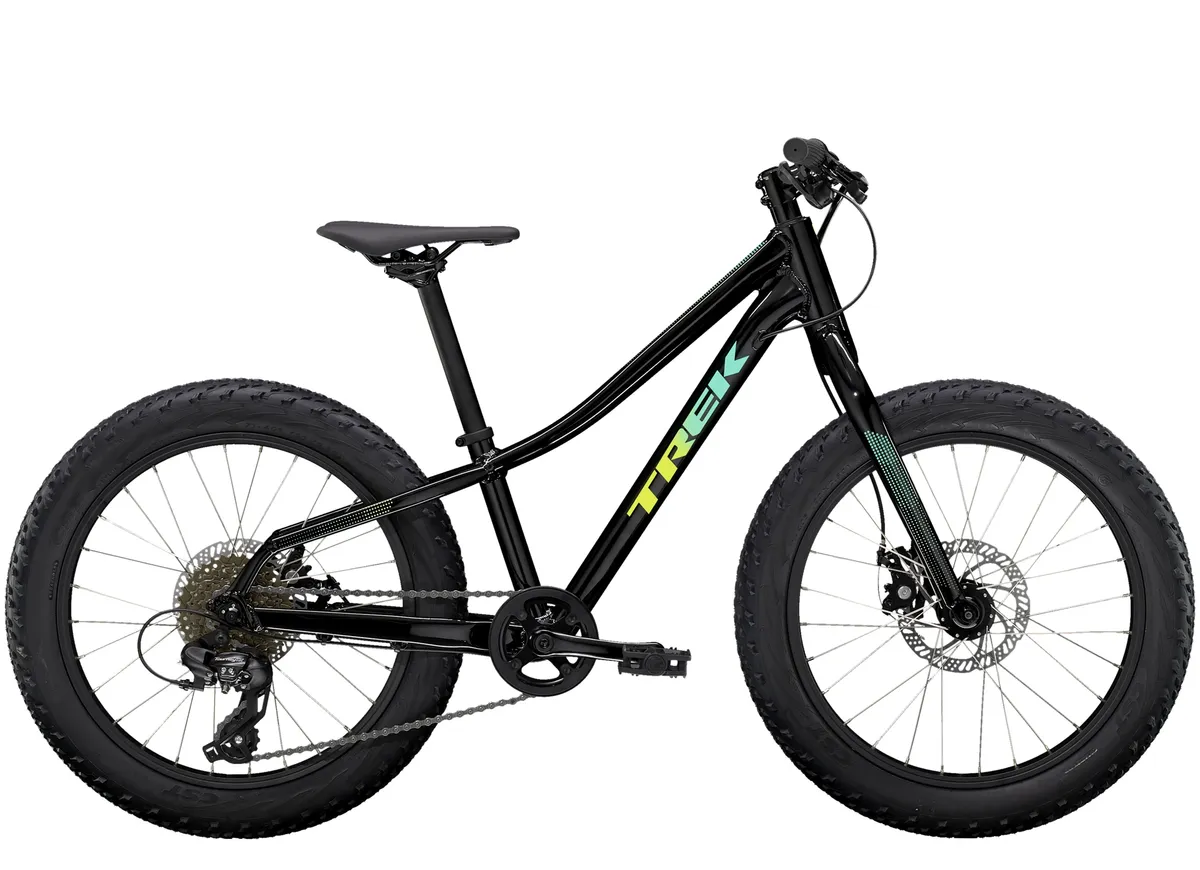
- £515 / €524 / $500
- 8-speed drivetrain
- Mechanical disc brakes
Trek's Roscoe 20 is designed to inspire youngsters' confidence with large 2.8in tyres that are able to take on the trails and the streets.
It has a rigid fork for simplicity, and cost and weight savings, but you'll spot plenty of details shared with Trek's adult-size bikes. These include a durable aluminium frame (with kid-specific geometry), a fuss-free 1x8 Shimano drivetrain with wide-range cassette, and Tektro mechanical disc brakes.
All of this adds up to a great base for building young riding skills.
Best bikes for ages 10 to 13
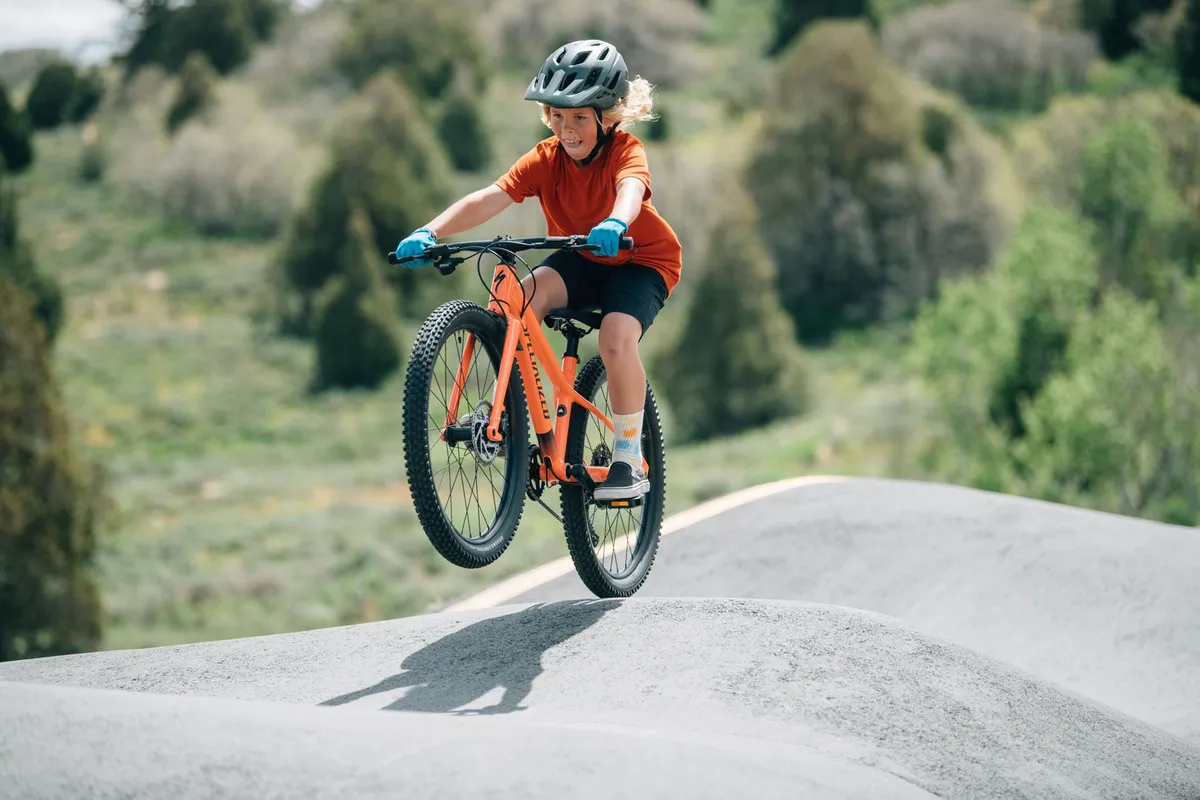
With a larger wheel size of 24in come many more features. These bikes are essentially smaller versions of adult bikes, with the variation, style and focus that goes with it.
You can get everything from drop-bar road bikes, hardtail and full-suspension options with disc brakes for budding mountain bikers, or sturdy and versatile flat-handlebar hybrid bikes.
Quality models will have light alloy frames and the spec should be comparable to an adult bike at the same price point.
Woom Off 6
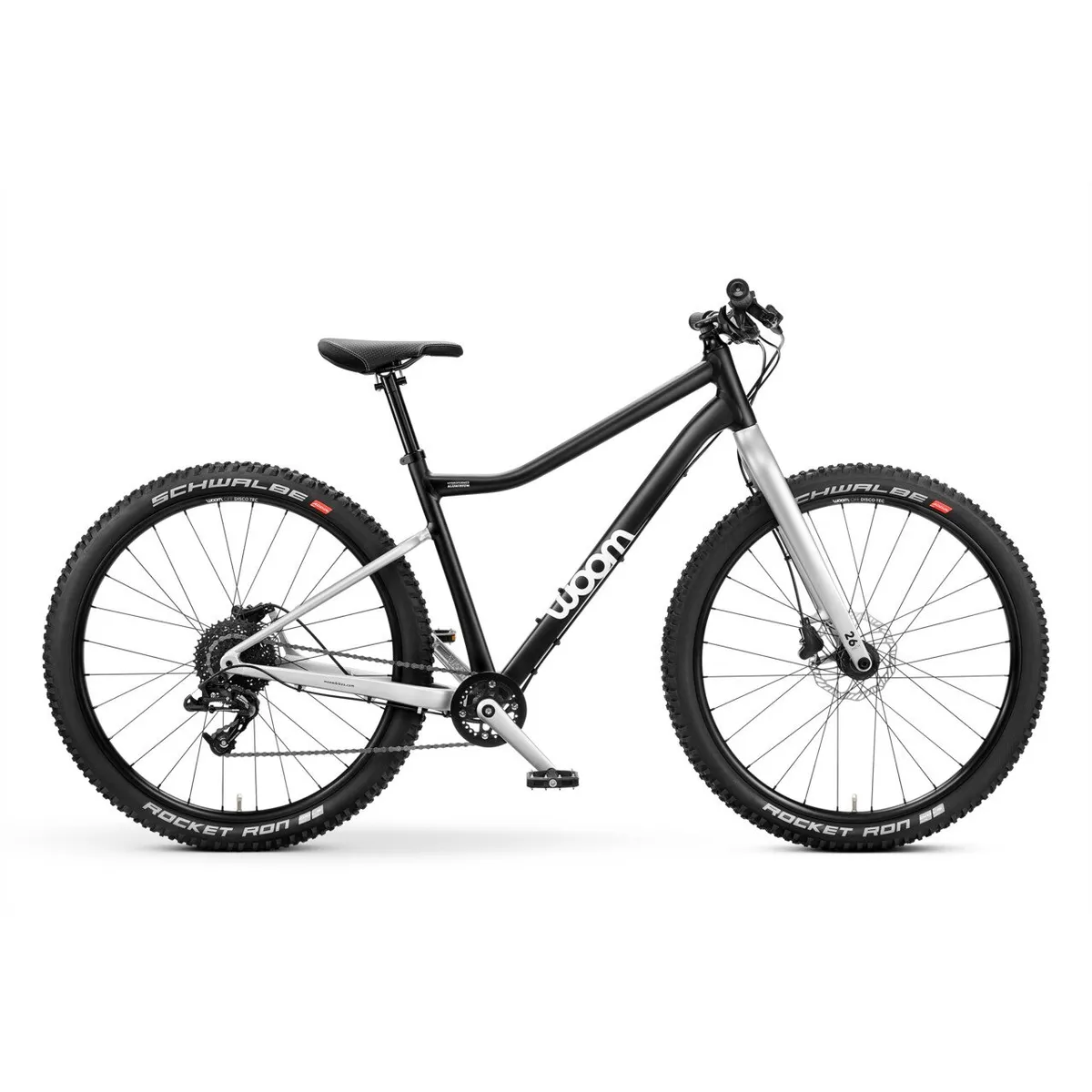
- Off 6: €899 / $899
- Off Air 6: €999 / $1,049
- Rigid or suspension fork options
- Hydraulic disc brakes
The largest of Woom’s kids' bikes, the Off 6 is an off-road build for riders from 140cm to 165cm (approximately 10 years and over). This model features a rigid carbon fibre fork, or you can opt for the Woom Off Air 6 to add 90mm of air suspension up-front.
Both options are built around a high-quality aluminium alloy frame with 26in wheels, and are kitted out with nine gears and hydraulic disc brakes.
Transition Ripcord
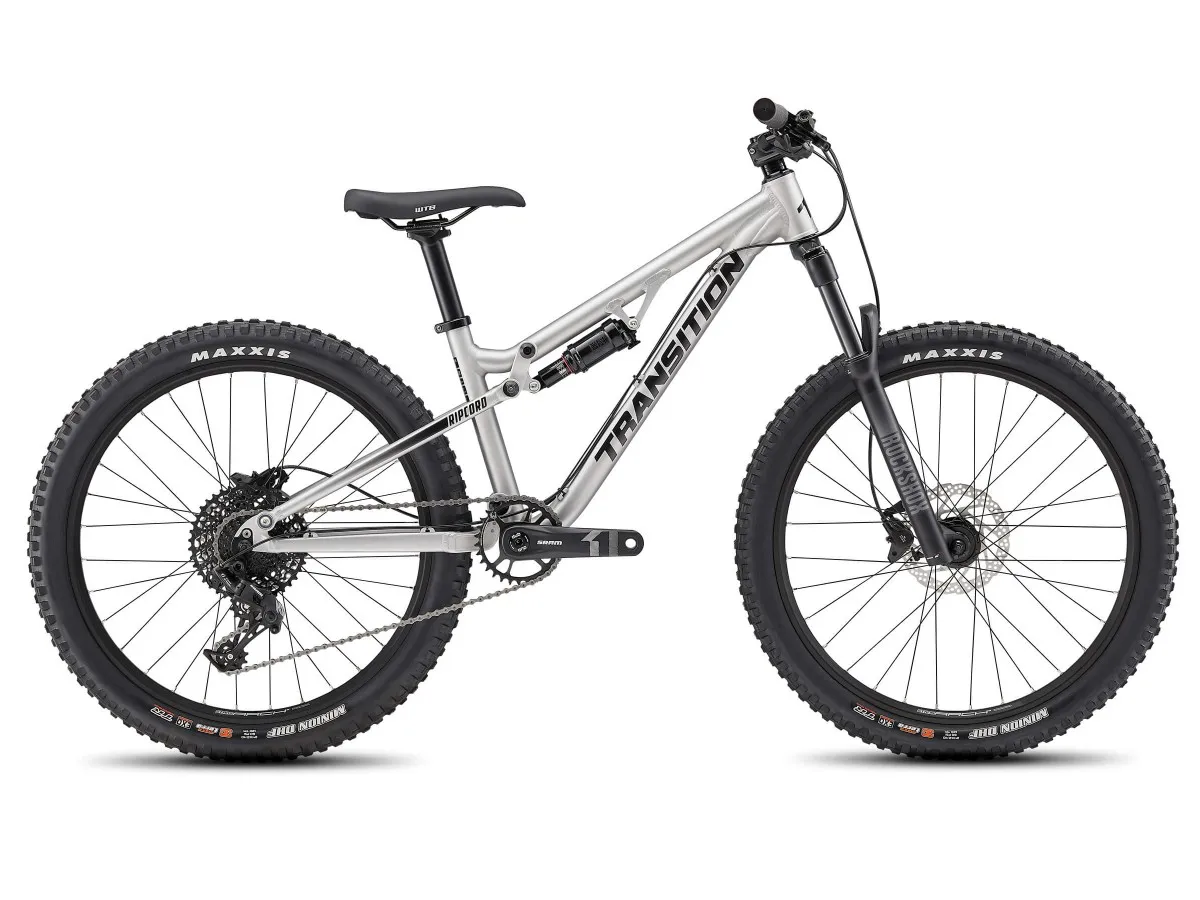
- £1,699 / $1,899
- Front and rear suspension
- Wide gear range with 11 speeds
With 100mm of front and rear travel, this full-susser is for young shredders who want to take on everything and anything.
The Ripcord offers a low standover height, progressive geometry, RockShox Judy fork and Monarch R shock, plus Shimano brakes and a SRAM NX 1x11 drivetrain.
Transition says the bike is designed for everything from trail shredding to bike-park ripping. With an air fork and shock, there's a good deal of adjustability too.
It's no surprise that the Ripcord is high on price with this spec, but this is a bike that won't be holding any child back.
Kona Honzo 24
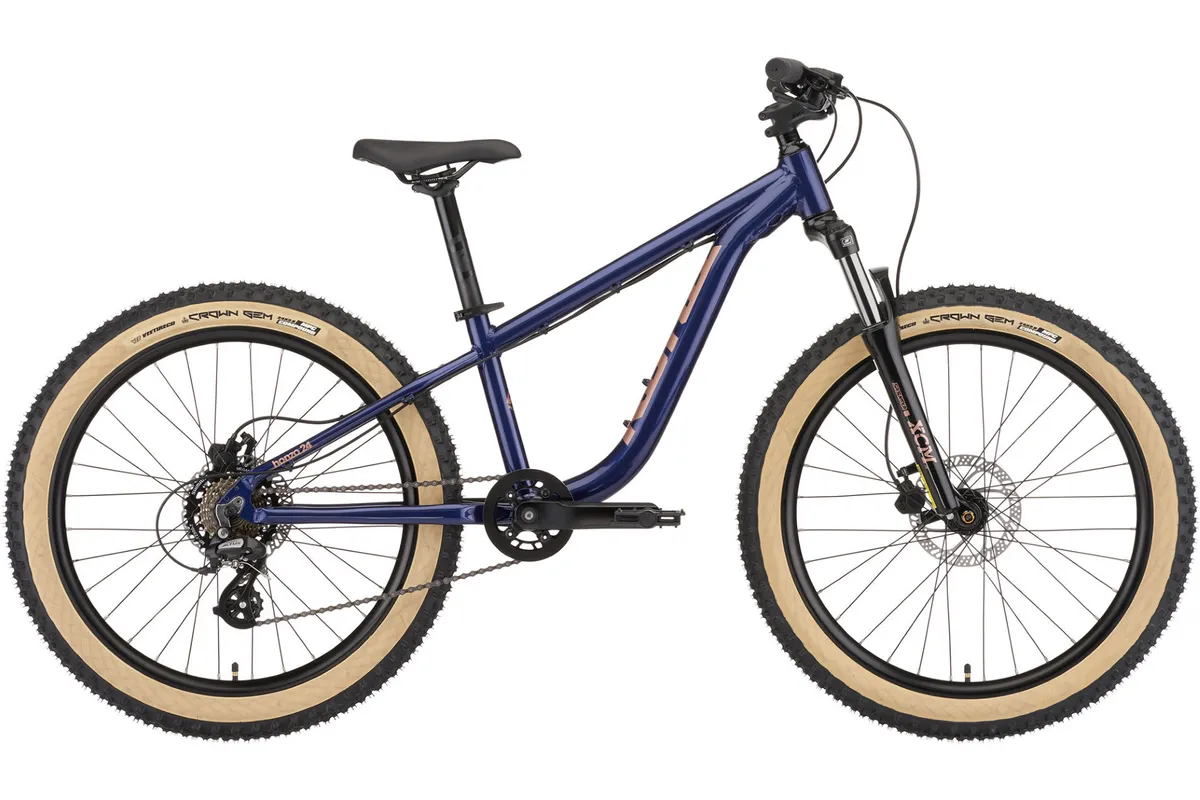
- £698.99 / €825.50 / $860 / AU$1,262
- Hardtail, suspension fork
- Hydraulic disc brakes
Equipped with 80mm of front travel, spongy 2.6in Vee tyres and hydraulic disc brakes, the Kona Honzo 24 is a trail tearaway's dream present.
The 24in wheels and 1x 7-speed Shimano / Samox drivetrain should suit pre-teens who are getting to grips with shifting.
Frog 69 and Frog 73

- Frog 69: £455 / €535 / $700
- Frog 73: £465 / €545 / $720
- Simple mechanicals
- Wide age range covered
Frog, a British company dedicated to making lightweight bikes for children, has a range of options including road bikes, mountain bikes and hybrids.
The 69 and 73 are both flat-bar hybrid bikes that are simple yet versatile enough to deal with the ride to school as well as after-school antics.
The number refers to the frame size, with the 69 suitable for ages 10 to 12 and the 73 for ages 12 to 14 (or thereabouts, height dependant).
Triban 500
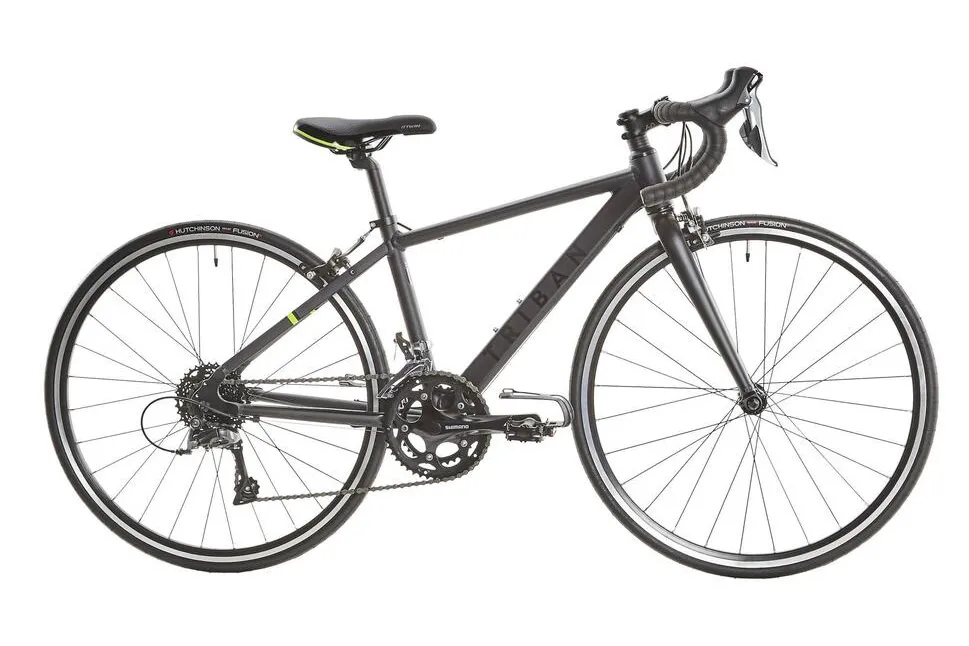
- £399.99
- Shimano Claris gears
- Alloy frame and fork
The Triban 500 could be an affordable first road bike for children aged 9 to 12 and 135cm to 150cm tall.
The alloy bike has a sub-10kg claimed weight, 650b wheels and an eight-speed Shimano Claris drivetrain.
The 46/34T double chainring and 11-34t cassette provides plenty of range for budding climbers.
Vitus 24

- £329.99 / €390 / $406 / AU$596
- Available in purple, silver and blue
- Off-road capable spec
With 24in wheels and several parts designed specially for children – including the saddle and handlebars – the Vitus 24 is a mountain bike for young ‘uns.
Vitus says it should fit children from 127cm to 142cm tall and the brake levers have adjustable reach.
Kenda tyres, Tektro brakes and an eight-speed Shimano Acera drivetrain round off the spec.
Best bikes for teenagers
For teenagers, you’ll be able to pick from a wide range of bikes, including smaller sizes of adult bikes. You can also get junior versions of bikes that have a slightly smaller wheel size, such as road bikes with 650b wheels rather than the adult 700c wheels, and mountain bikes with 26in wheels rather than the now more common 27.5in wheels, or even 29ers.
You may want to consult (stealthily if it’s supposed to be a surprise purchase) with your child about the type, brand and colour of bike they’re after.
If your teenager is really getting into their sport, there are now plenty of high-quality race-ready road and mountain bikes that will cultivate their competitive edge.
Islabikes Creig
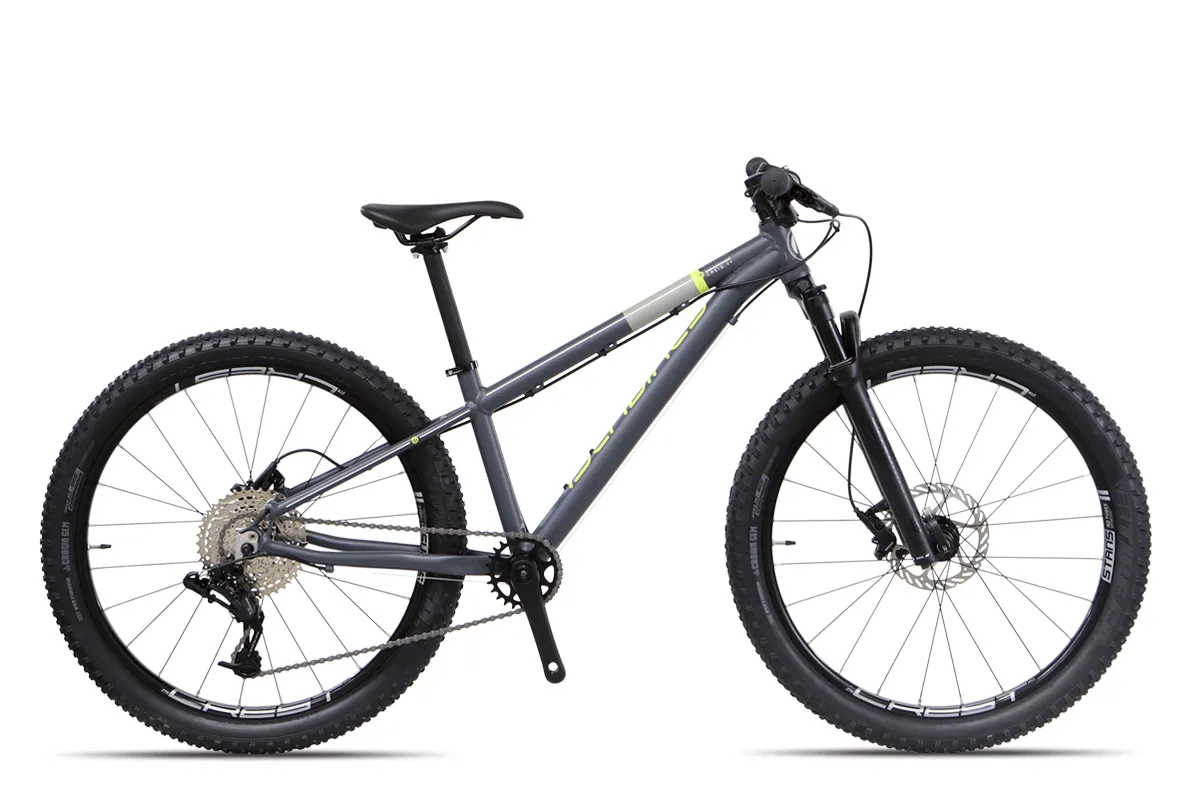
- £799.99–£1,099.99
- Four wheel size options
- Suspension fork can be tuned to the rider's weight
The Creig is an aluminium-framed hardtail mountain bike with progressive geometry, that's designed to suit a smaller rider. A high-quality RockShox 30 Gold air fork can be tuned to suit the child's weight and riding conditions.
Four wheel sizes mean there's a Creig for riders aged from just eight years right the way through to teens.
The Creig 27's spec highlights include that adjustable RockShox air fork, SRAM Level hydraulic disc brakes and a single-chainring transmission from SRAM.
Islabikes Luath
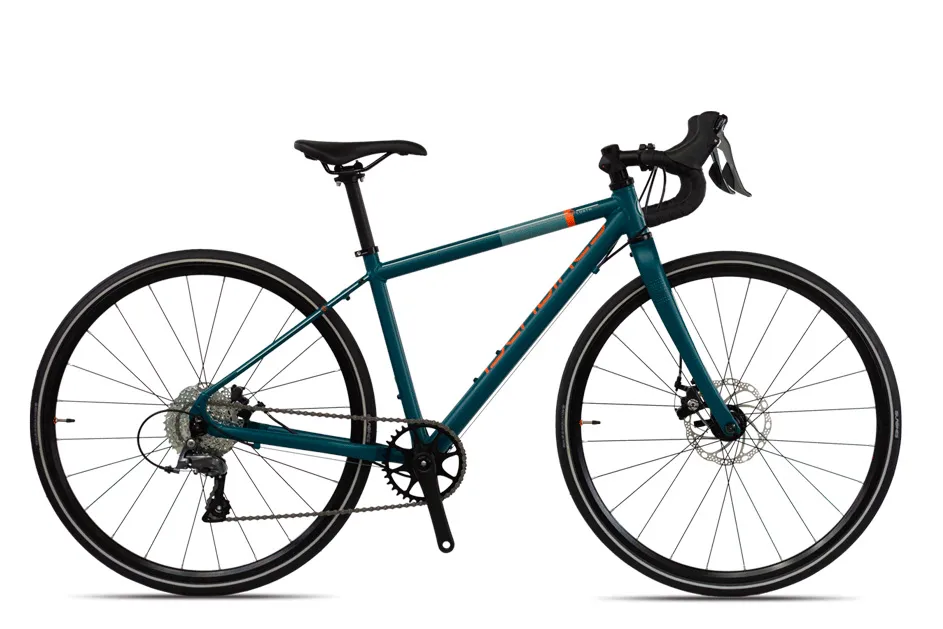
- £799.99–£899.99
- Can be set up for road, cyclocross or gravel riding
- Mechanical disc brakes
The Luath from Islabikes is such a versatile bike that you can order it with road, cyclocross or gravel tyres. Like the rest of Islabikes' range, it's a proper scaled-down version of a serious bike that will do justice to even the most committed of young riders.
Spec highlights include a lightweight aluminium frame with a carbon fork, Tektro cable disc brakes with levers designed specifically for smaller hands and a 1x drivetrain that keeps things simple, secure and light.
Four sizes mean there are options for riders from just eight years old through to mid-teens.
Canyon Grand Canyon Young Hero

- £699 / €649
- 11-speed Shimano gears
- Shimano hydraulic disc brakes
Inspired by the adult Grand Canyon range, this 27.5in-wheel hardtail mountain bike is designed to provide a competent introduction to the world of off-road riding.
The sleek aluminium frame is fitted with a 100mm SR Suntour XCR suspension fork for control as well as comfort, while Shimano MT200 hydraulic disc brakes provide plenty of easy-to-use stopping power.
The Grand Canyon Young Hero has 11 gears from its Shimano Deore M5100 groupset.
Grips, saddle, pedals and cockpit are all Canyon’s own, and are designed to suit smaller riders.
Frog Bikes 70

- £620
- Multi-surface drop bar bike
- 9.3kg claimed weight
Frog Bikes says the Frog Road 70 is suitable for children in their early teens who enjoy riding on and off road.
The stock Kenda tyres are road slicks. But the frame has clearance for wider, knobbly tyres to be fitted to the 26in wheels, according to the brand.
The cantilever brakes are Tektro Oryx. For extra security, auxiliary brake levers sit on top of the short-drop handlebars.
The Frog Road 70’s 10-speed drivetrain comprises a sensibly sized 36T single chainring and 11-34t cassette.
Buyer's guide to choosing kids' bikes
The most important factors to consider when choosing a bike for your child are height and ability.
The weight of the bike will also affect its handling, and bikes at the very low end of the price spectrum are often the heaviest.
Why it’s important to get the right size

Kids grow remarkably fast, and no one knows that better than their parents!
While it might be tempting to buy a bike that’s a little too large for your child for them to ‘grow into’, this can actually hamper the learning process and make it much harder for them.
Riding a bike that’s too big can not only make it more difficult to manoeuvre and affect their stability, but it can also really take the fun out of the process. If you want your child’s first memories of cycling to be positive and enjoyable, then making sure you find a bike that’s the perfect size for them at their current measurements is really key.
How bikes differ in size

There are two ways in which children’s bikes differ in size: the wheels and the frame. These two major elements increase in size in tandem as the child grows. However, unlike adult bikes, kids’ bikes are typically measured and sold by wheel size.
The smallest wheels you’re likely to find are tiny 12-inch wheels on balance bikes, and they go up progressively to 26 inches for some bikes designed for teenagers. Sizes typically increase in two-inch increments. The frames are designed with geometry to accommodate the increasing wheel size as children grow.
On smaller frames, you’ll find correspondingly reduced-size components too, from smaller, adjustable-reach brake levers to shorter cranks.
Check out our guide to kids’ bike wheel sizes for more help on what size bike to choose.
How to choose the right size bike
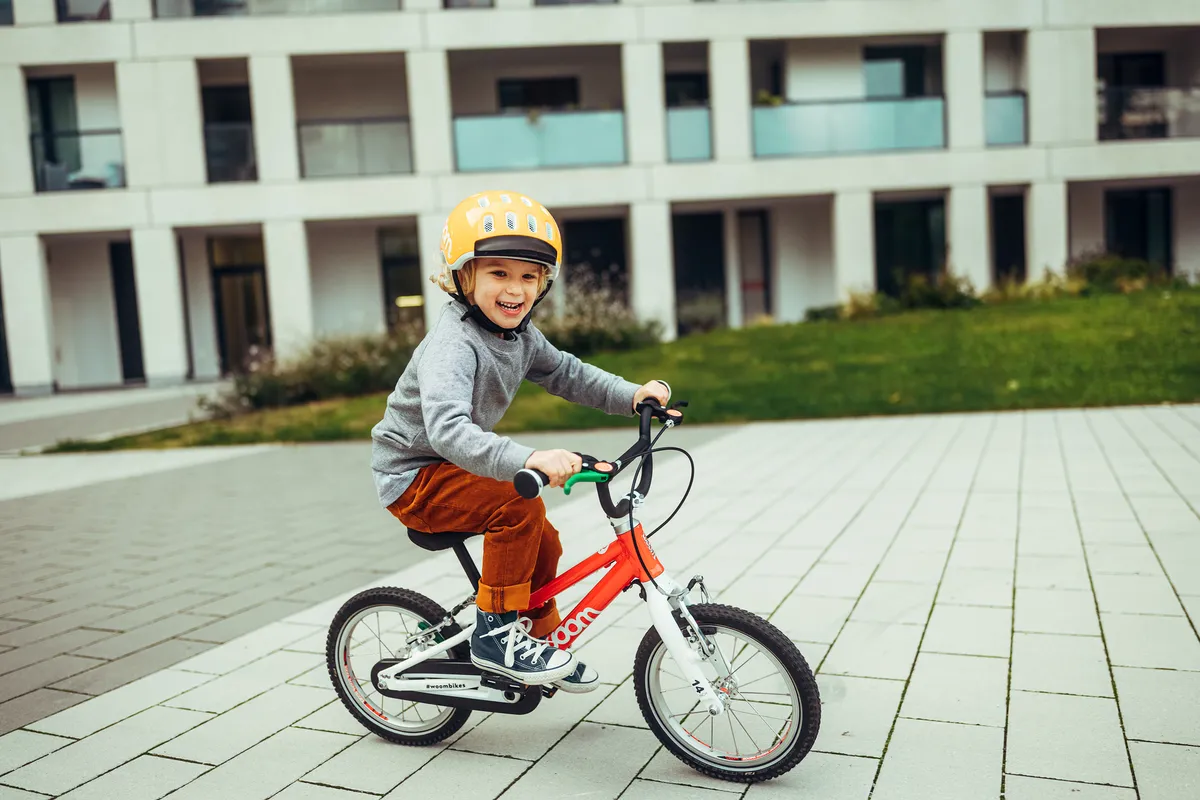
You can pretty much disregard the age of your child when it comes to choosing the right size bike: height and inseam length are much more important, as kids grow at such varying rates.
You’ll find that most brands offer size guides for helping you to choose the best-sized bike. For example, Woom and Islabikes both offer inseam charts, accompanied by tips for measuring your child.
When it comes to sitting your child on the bike that you’re looking to buy, you need to make sure that they can reach both feet on the ground while sitting on the saddle.
This is not only important for giving a good pedalling position, but also allows the child to stop and put their feet down when they want to.
The second element of the fit is the reach. You need to make sure that they can not only comfortably reach the handlebars with both hands, but also the brake levers – and be able to operate these easily. Some bikes will be built with adjustable-reach brake levers, so check for these.
What if your child is in between sizes?
Again, as tempting as it might be to size up like you might with school uniform or shoes, it’s usually best here to choose the smaller size. Why is that?
Well, a larger bike will typically be harder for a child to steer, stop and start, especially where they might need to stand on their tiptoes to reach the floor. This larger bike might feel more intimidating and less comfortable, especially for less confident riders.
As the feelings of control, security and confidence are key to an enjoyable cycling experience for kids, it’s clear to see why a smaller bike is likely to offer a better experience here if you’re unsure between sizes.
The exception to this guidance would be that if the child is really on the cusp of the larger size, it might be a better idea because they’ll be able to enjoy riding it for much longer, as well as have a more efficient pedal stroke on the larger bike.
How long until a child outgrows their bike?
Of course no two children are the same or grow at the same rate, but some brands suggest that their bikes last an average of two years before they're outgrown. This is if it's purchased when the child fits in the lower end of the sizing bracket.
This might not seem like long at all, but thankfully many of these quality children’s bikes hold excellent resale value. Some brands also offer trade-in schemes when you purchase a larger-sized bike.
How a child's cycling skill can affect size
Interestingly, it’s not only your child’s measurements that can dictate which size will be best for them. Their skill level also has a bearing on what size and weight of bike will be best.
A less confident or less skilled child might really benefit from a slightly smaller, more lightweight bicycle. This is because they tend to be easier for the child to handle and manoeuvre, as well as to get onto and dismount.
Having said this, the key part will still be getting the basic fit right, again for your child’s physical size, rather than age.
How to teach a child to ride a bike
Need to teach a child how to ride? We've got a separate guide on how to teach a child to ride a bike in only 30 minutes. Or just watch the video tutorial below.
We've also got a guide on how to teach a child to ride a balance bike.
What type of bike should I buy?
Balance bike vs pedal bike

First things first, when it comes to kids’ bikes, what’s on offer?
You might be thinking it’s just a shrunken-down adult bike, but in reality it's a little different. There’s a lot to consider when buying a kids’ bike but, broadly speaking, let’s start with the two main options: a balance bike and a pedal bike.
Balance bikes have become really popular over recent years as a child’s first bike, and with good reason too, which we’ll come on to later. Alternatively, there’s the more traditional approach of small pedal bikes, often fitted with removable stabiliser wheels.
Children’s bikes tend to feature flat bars rather than the drop bars we’re used to seeing on road bikes, especially for younger ages. As they grow, you are likely to find more choice, including rigid and suspension bikes, with hybrids and hardtails on offer.
The first stages of teaching a child how to ride a bike are really crucial, and the balance bike has been something of a revelation for many keen parents – not to mention kids.
These simple little bikes don’t feature pedals, and some don’t have a brake either. The clue is in the name: a balance bike teaches the child fundamental balancing skills, which they simply don’t get by riding a pedal bike fitted with stabilisers.
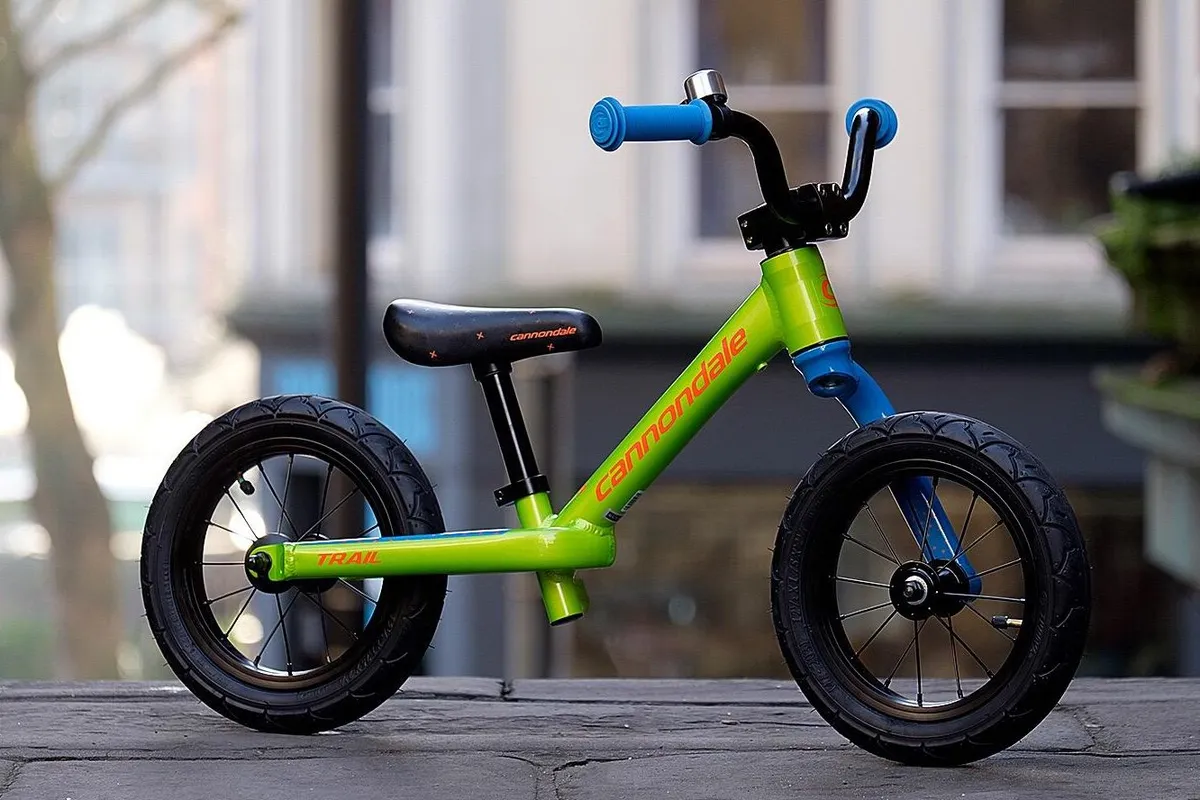
In fact, the technique for cornering a bike with or without stabilisers is really quite different, as stabiliser wheels effectively turn the bike into a tricycle, so starting out with stabilisers can actually complicate, rather than aid, the learning process.
By learning on a balance bike, kids can master balance, steering and sometimes braking techniques from the very start, which they can then build on when it comes to upgrading to their first pedal bike, and adding the challenge of pedalling.
Balance bikes are great for children from as soon as they start walking to around four years old, although the time to switch to a pedal bike will vary according to the child’s capability.
Some will take a little longer to grasp these early skills and others will pick them up much faster.
Types of bikes with pedals
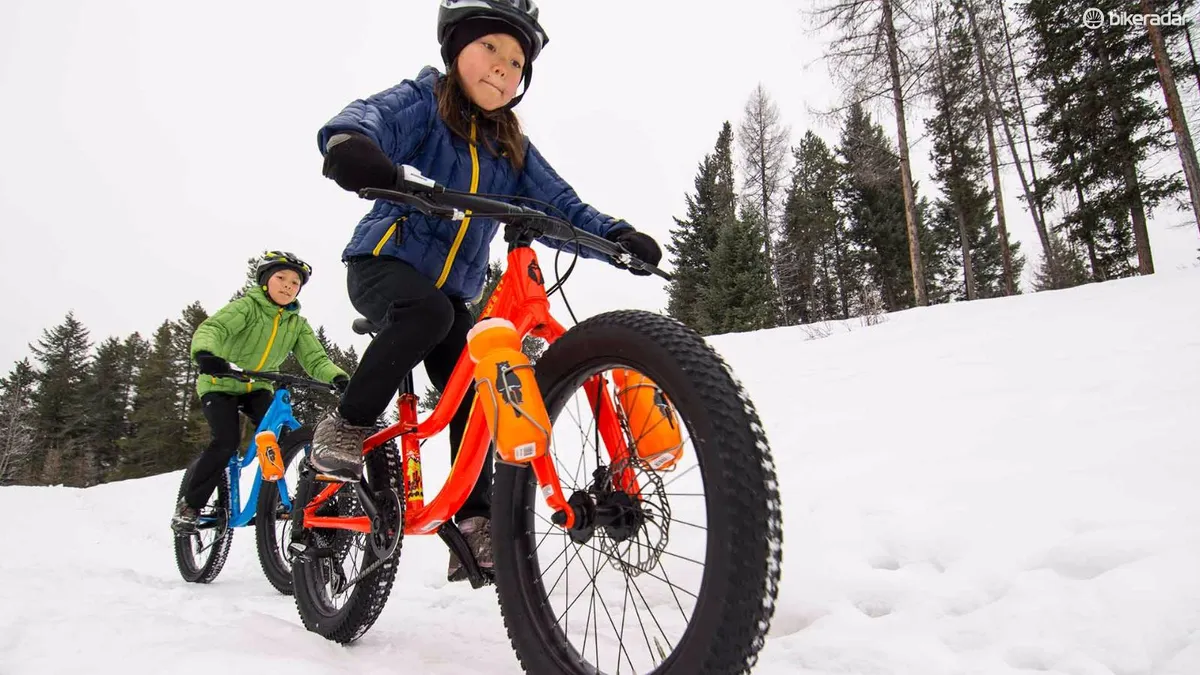
The different styles of bikes will be more varied as your child grows. In the early stages, kids’ bikes tend to be rigid, flat-bar bikes, from balance bikes through to early pedal cycles. Off-road bikes with wider tyres and potentially a suspension fork comes later, as do drop-bar road bikes.
What’s essential is getting the fundamental skills mastered in the early stages, rather than trying to specialise into any particular cycling discipline yet.
Should you buy a bike with suspension?

Thinking of looking for a bike with suspension for your budding shredder? In short, don’t. For really young children, when inflated to the correct pressures, tyres can provide all the suspension they need.
For children of a really young age and small size, suspension forks not only make the bike much heavier, and therefore harder to handle, but can also be a lot more expensive.
It’s much better to opt for a rigid bike with good brakes and wider tyres, leaving the added complication of suspension for when they’ve grown a little and mastered the fundamentals without it.
Weight
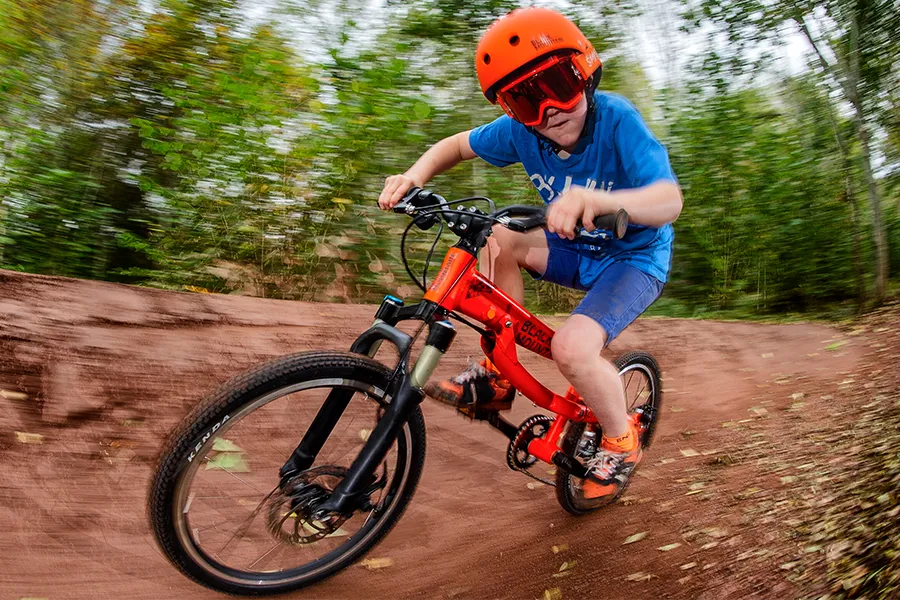
Bike weight is something we’ve mentioned already, but it’s worth emphasing again.
Because children are much lighter than adults, their bike’s comparative weight becomes really important, and has a big effect on how easy the bike is to ride and handle.
It’s a good idea to choose the lightest bike that you can afford within your budget at the optimum size for your child. This should make the whole process more enjoyable for your young cyclist, and for you too!
Gears and brakes

Don’t be surprised if the bikes you’re looking at don’t feature many gears – this doesn’t mean bad value for money. These are typically reserved for larger kids’ bikes, and hence older children, so that there are only one or two new things to concentrate on learning for each new bike size.
Many first pedal bikes will be either singlespeed or only feature a few gears. As they increase in size, you’ll find 8-speed cassettes and single chainring options, for example.
As well as keeping things simple in the early stages, limiting the gears also helps to keep bikes lightweight. There's also less to go wrong or break. As a child grows in both size and ability, gears become more important for longer rides, where they’re more likely to encounter a hill or two.
You’re likely to find either rim or disc brakes, with levers on the handlebars. You might even find a pedal brake, or coaster brake, which is a legal requirement for kids’ bikes with a maximum seat height of 25in or less that are sold in the US.
While coaster brakes, which are applied by backpedalling, are often thought to be easier for children to use, causing fewer accidents due to harsh braking, they don’t give quite as much control as rim or disc brakes, especially when it comes to riding off-road.
On the handlebars, the brakes are not only smaller than adults’ bikes, but also feature adjustable brake levers so you can reduce the reach for smaller hands. Gear shifting is often through a grip shifter, which can take less strength to shift.
Protection
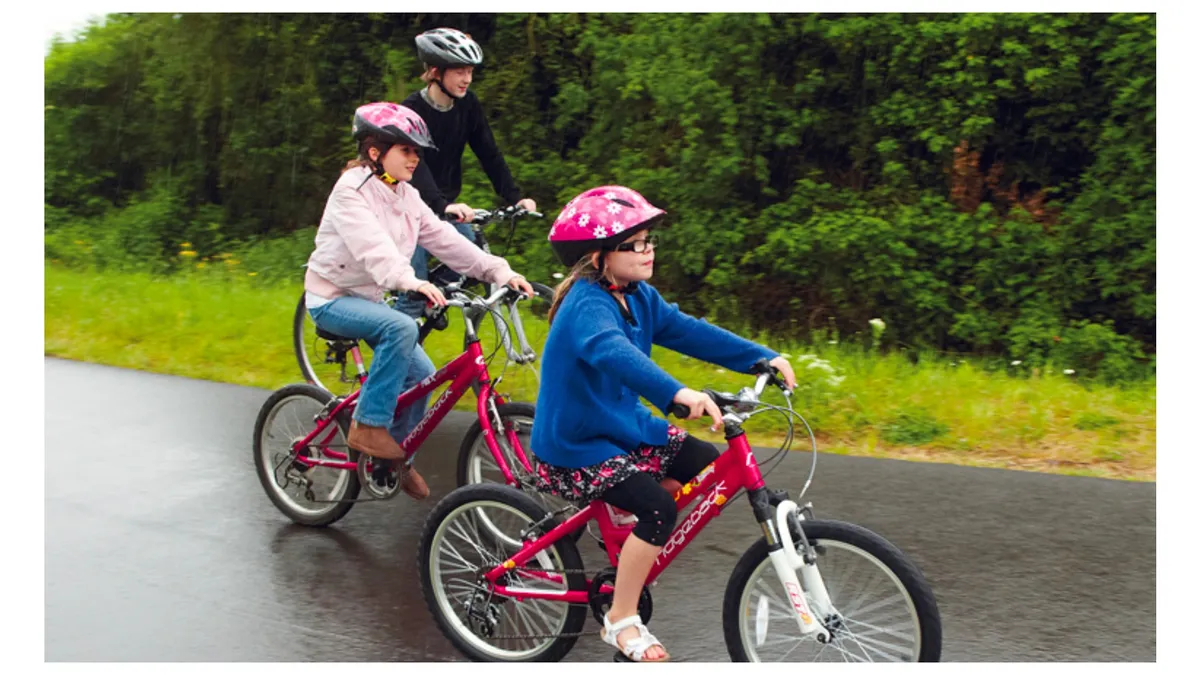
While you're shopping for your child’s first bike, it’s also a really good idea to check out the protection on offer. A helmet is crucial here, and it needs to be well-fitting to be safe. Before you buy make sure that it doesn’t move around at all when fitted.
Our buyer’s guide to kids’ helmets offers a few recommendations, as well as help to ensure you get a well-fitting helmet for your child.
For children just getting to grips with riding, it might be a good idea to invest in some knee and elbow pads too, which can help avoid the almost inevitable bumps and scrapes that come with learning how to ride.
One final point worth mentioning – many kids’ bikes come with a chainguard and that’s often useful to keep little hands clean and safe.
Over to you
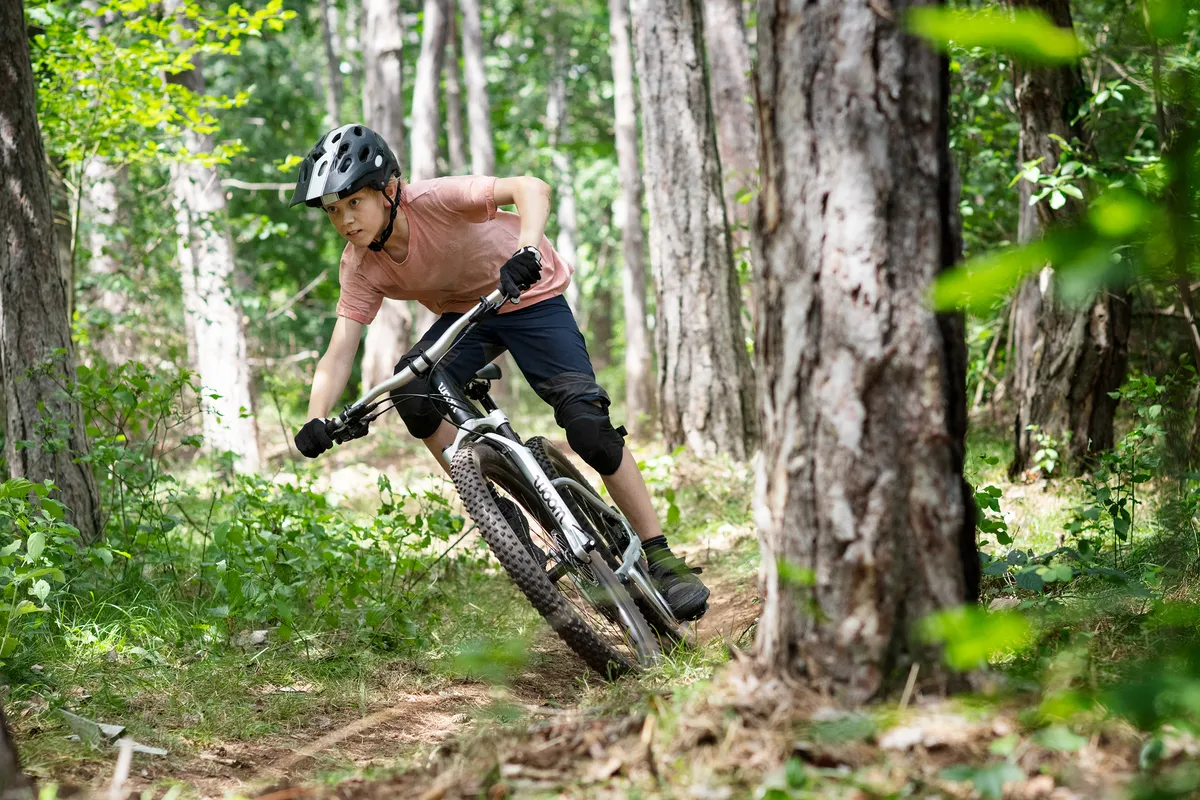
And there you have it – everything you need to know about buying a kids’ bike.
There’s quite a lot to think about when choosing a bike for a child, but essentially the most crucial parts are getting the size right, and making sure your little cyclist feels comfortable, safe and confident in the saddle.
A fun and happy learning experience is key to building a hobby that a kid will keep coming back to. It will also ensure that you really get your money’s worth from your investment, rather than the bike simply getting relegated to the shed and forgotten about!
Finally, if you are considering doing the school or nursery run by bike, we have plenty of advice for commuting with kids.
